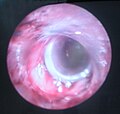Bronchoscopy
procedure allowing a physician to look at a patient's airways through a thin viewing instrument called a bronchoscope From Wikipedia, the free encyclopedia
Remove ads
Bronchoscopy is a medical procedure which is used to look at the inside of a person's airways. It can be used to see the inside of the trachea, and the bronchi and bronchioles within the lungs. There are three types of bronchoscopy: rigid, flexible fiberoptic bronchoscopy and CT virtual bronchoscopy (CTVB).

Remove ads
Rigid bronchoscopy
Rigid bronchoscopy is a straight rigid tube used to see into the trachea and proximal bronchi. It is usually done in an operating room under general anesthesia. It is usually used when there is a blockage in either the trachea or the primary bronchi. The diameter of the tube is large enough to insert instruments to remove obstructions.[1]
Flexible fiberoptic bronchoscopy
During the procedure, a thin, flexible fiberoptic tube, called a bronchoscope, is passed through the nose or mouth nose into the airways. The bronchoscope has a light and a camera which lets the doctor see into the airway.[2]
CT virtual bronchoscopy
This technique uses data from multiple CT scans to create a three dimensional (3D) image. This allows doctors to see what is going on without having to operate.[3]
References
Wikiwand - on
Seamless Wikipedia browsing. On steroids.
Remove ads




